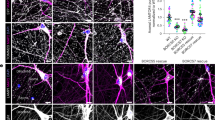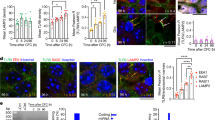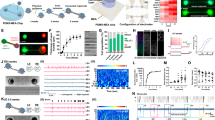Abstract
Neurotransmitter release at synapses between nerve cells is mediated by calcium-triggered exocytotic fusion of synaptic vesicles1. Before fusion, vesicles dock at the presynaptic release site where they mature to a fusion-competent state1,2. Here we identify Munc13-1, a brain-specific presynaptic phorbol ester receptor3,4, as an essential protein for synaptic vesicle maturation. We show that glutamatergic hippocampal neurons from mice lacking Munc13-1 form ultrastructurally normal synapses whose synaptic-vesicle cycle is arrested at the maturation step. Transmitter release from mutant synapses cannot be triggered by action potentials, calcium-ionophores or hypertonic sucrose solution. In contrast, release evoked by α-latrotoxin is indistinguishable from wild-type controls, indicating that the toxin can bypass Munc13-1-mediated vesicle maturation. A small subpopulation of synapses of any given glutamatergic neuron as well as all synapses of GABA (γ-aminobutyric acid)-containing neurons are unaffected by Munc13-1 loss, demonstrating the existence of multiple and transmitter-specific synaptic vesicle maturation processes in synapses.
This is a preview of subscription content, access via your institution
Access options
Subscribe to this journal
Receive 51 print issues and online access
$199.00 per year
only $3.90 per issue
Buy this article
- Purchase on Springer Link
- Instant access to full article PDF
Prices may be subject to local taxes which are calculated during checkout




Similar content being viewed by others
References
Südhof, T. C. The synaptic vesicle cycle: a cascade of protein–protein interactions. Nature 375, 645–653 (1995).
Zucker, R. S. Exocytosis: a molecular and physiological perspective. Neuron 17, 1049–1055 (1996).
Brose, N., Hofmann, K., Hata, Y. & Südhof, T. C. Mammalian homologues of C. elegans unc-13 gene define novel family of C2-domain proteins. J. Biol. Chem. 270, 25273–25280 (1995).
Betz, A.et al. Munc13-1 is a presynaptic phorbol ester receptor that enhances neurotransmitter release. Neuron 21, 123–136 (1998).
Stevens, C. F. & Tsujimoto, T. Estimates for the pool size of releasable quanta at a single central synapse and for the time required to fill a pool. Proc. Natl Acad. Sci. USA 92, 846–894 (1995).
Rosenmund, C. & Stevens, C. F. Definition of the readily releasable pool of vesicles at hippocampal synapses. Neuron 16, 1197–1207 (1996).
Zucker, R. S. Changes in the statistics of transmitter release during facilitation. J. Physiol. 229, 787–810 (1973).
Zucker, R. S. Short-term synaptic plasticity. Annu. Rev. Neurosci. 12, 13–31 (1989).
Rosenmund, C., Clements, J. D. & Westbrook, G. L. Nonuniform probability of glutamate release at a hippocampal synapse. Science 262, 754–757 (1993).
Hessler, N. A., Shirke, A. M. & Malinow, R. The probability of transmitter release at a mammalian synapse. Nature 366, 569–572 (1993).
Rosenmund, C., Feltz, A. & Westbrook, G. L. Synaptic NMDA receptor channels have a low open probability. J. Neurosci. 15, 2788–2795 (1995).
Geppert, M.et al. Synaptotagmin I: a major Ca2+-sensor for transmitter release at a central synapse. Cell 79, 717–727 (1994).
Krasnoperov, V. G.et al. α-Latrotoxin stimulates exocytosis by the interaction with a neuronal G-protein-coupled receptor. Neuron 18, 925–937 (1997).
Lelianova, V. G.et al. α-Latrotoxin receptor, latrophilin, is a novel member of the secretin family of G-protein coupled receptors. J. Biol. Chem. 272, 21504–21508 (1997).
Martin, T. F. Mechanisms of protein secretion in endocrine and exocrine cells. Vitamins Hormones 54, 207–226 (1998).
Bekkers, J. M. & Stevens, C. F. Excitatory and inhibitory autaptic currents in isolated hippocampal neurons maintained in culture. Proc. Natl Acad. Sci. USA 88, 7834–7838 (1991).
Boyer, C., Schikorski, T. & Stevens, C. F. Comparison of hippocampal dendritic spines in culture and in brain. J. Neurosci. 18, 5294–5300 (1998).
Acknowledgements
We thank J. Rettig and U. Ashery for stimulating discussions; S. Röglin, A. Kanbach and C. Casper for help with animal colonies; J. Ficner and R. Schubert for artwork; I. Herfort, S. Schmidt and S. Wenger for technical assistance; and F. Benseler and I. Thanhäuser for DNA synthesis and sequencing. This work was supported by grants from the German Research Foundation and the Max-Planck-Society. C.R. and N.B. are Heisenberg Fellows of the German Research Foundation.
Author information
Authors and Affiliations
Corresponding author
Supplementary information
Rights and permissions
About this article
Cite this article
Augustin, I., Rosenmund, C., Südhof, T. et al. Munc13-1 is essential for fusion competence of glutamatergic synaptic vesicles. Nature 400, 457–461 (1999). https://doi.org/10.1038/22768
Received:
Accepted:
Issue Date:
DOI: https://doi.org/10.1038/22768
Comments
By submitting a comment you agree to abide by our Terms and Community Guidelines. If you find something abusive or that does not comply with our terms or guidelines please flag it as inappropriate.



